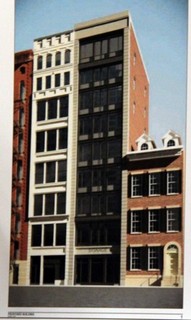
Rendering of proposed building at 27 East 4th Street. Image Courtesy: SRA Architecture and Engineering.
Applicants take measures to ensure construction does not harm adjacent Merchant’s House. At a public meeting on February 11, 2014, the Landmarks Preservation Commission reviewed a revised proposal for a new building at 27 East 4th Street in the NoHo Historic District Extension. The applicants returned with a revised plan following Commissioners’ comments at a public hearing on March 12, 2013 (Read Cityland past coverage here).
The proposal was presented by Edward Carroll of SRA Architecture and Engineering on behalf of the applicant Gary Spindler. Carroll stated that the height of the building was reduced by one story, to nine floors, no longer making it the tallest building on the block, while deepening the floor plate to maintain the amount of floor area. The building would retain its steel structure, with a facade of transparent and translucent glass, and maintain a classical arrangement of base, shaft and cornice. The steel structure would be in shades of tan, contrasting with the gray of the glass, which Carroll called a “subtle palate” that was more sensitive to the neighborhood than the previous scheme.
The rear facade, which would be publicly visible from Shinbone Alley, would be clad in brick with punched window openings, metal lintels and concrete sills. Metal mesh on the rear facade would be introduced as “an abstracted version” of the old fire shutters. The rear facade would be illuminated by “low-wattage” light fixtures. In response to a commissioner question, Carroll said the property would be used for a commercial purpose, possibly as hotel or as commercial lofts.
Carroll stated that applicants had agreed to an enhanced monitoring program to ensure the no damage occurred to the Merchant’s House, after meeting with the Parks Department, the Department of Buildings, and the engineers for the adjacent property.
Chair Robert B. Tierney read from a letter from the Parks Department, which stated that the agency deemed the enhanced monitoring plan, which would include a pre-construction survey of the Merchant’s House and exceed Building Code requirements, satisfactory. Carroll said the developers had reached an accord with the engineers for The Merchant’s House. Landmarks’ Counsel John Weiss stated that Tim Lynch, Executive Director of the Department of Buildings’ Forensic Engineering Unit, had also determined that the plan was appropriate.
Commissioner Margery Perlmutter opined that the project was “a lot closer” to approval, but found the proportions unresolved, and recommended adjusting the building’s floor-to-floor heights. Commissioner Michael Goldblum determined that the reduction in height improved the proposal and the rear facade was acceptable, but found that the design of the front facade unsuccessfully “straddled a fence” that is neither contemporary nor historical. Commissioner Fred Bland said that while he was unqualified to comment on the engineering reports, he would defer to the expertise of Buildings and Parks. He also stated that he did not believe “the world stops around a historic building.” Bland and Commissioner Libby Ryan concurred that the illumination on the rear was not appropriate.
Chair Tierney asked that the applicants make further revisions and return to make presentation before the Commission. He asked them to continue to study structural issues revolving around the Merchant’s House to forestall any potential damage to the historic plaster.
LPC: 27 East 4th Street, Manhattan (13-0884) (February 11, 2014).
By: Jesse Denno (Jesse is a full-time staff writer at the Center for NYC Law).

